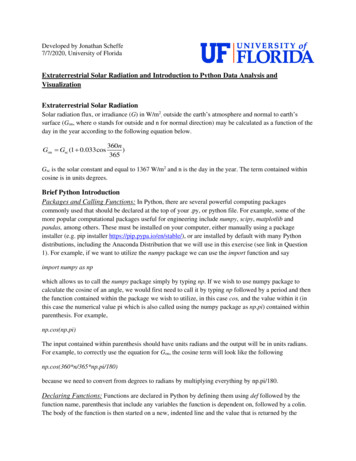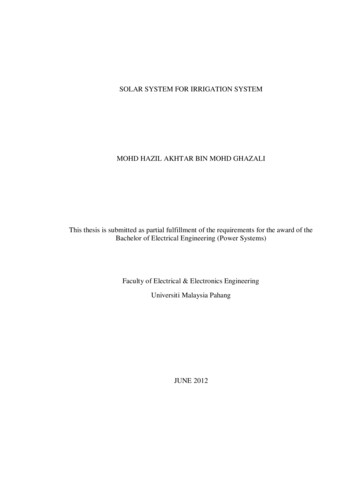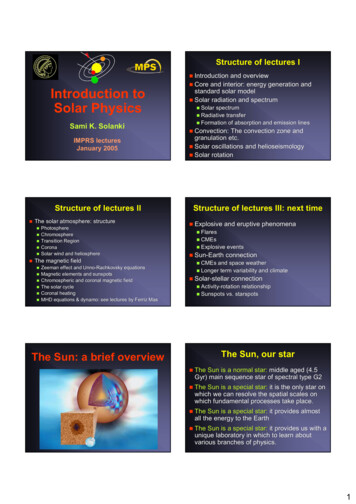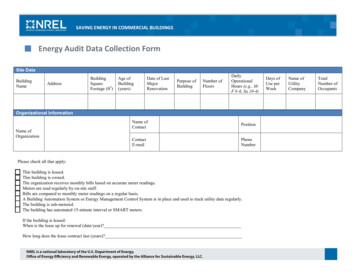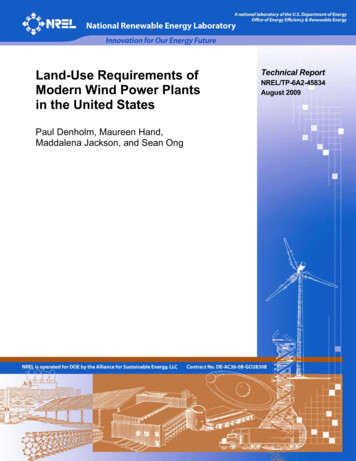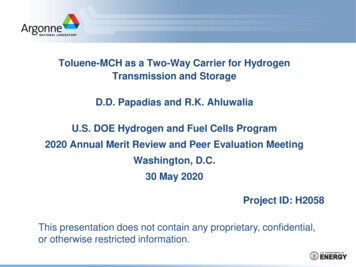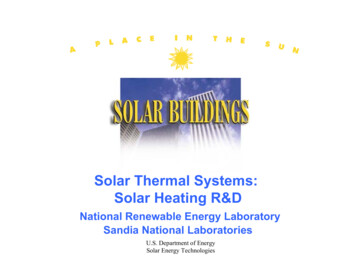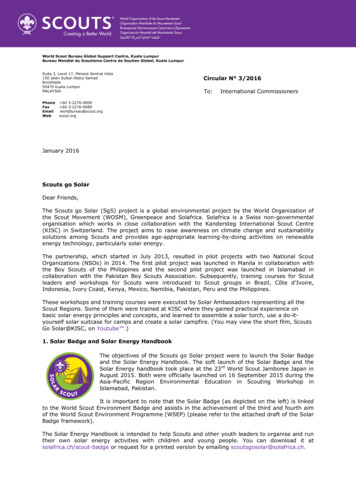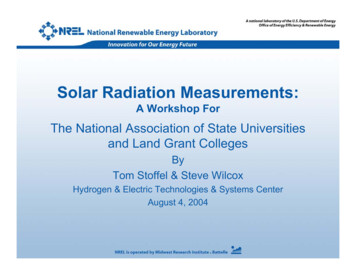
Transcription
Solar Radiation Measurements:A Workshop ForThe National Association of State Universitiesand Land Grant CollegesByTom Stoffel & Steve WilcoxHydrogen & Electric Technologies & Systems CenterAugust 4, 2004
Outline Introductions Shining On,–––––A Primer on Solar Radiation DataWhat are solar radiation measurements?Why do we need solar radiation data?What influences the amount of solar radiation?How do we use solar radiation data?How accurate do the data need to be? How are we meeting our solar radiation data needs? Where can you obtain solar radiation data? Pop Quiz– No acronyms!
IntroductionsTom Stoffel & Steve WilcoxResource Integration GroupMeasurement & Instrumentation TeamGeographic Information System Team40 years experience:– Solar measurement station/network design SRRL, HBCU, Saudi, DOE/ARM, NOAA, WMO/BSRN, GAW– Radiometer calibration and characterization BORCAL/RCC IPCs, NPCs– Solar data quality assessment SERI-QC DQMS
What are Solar RadiationMeasurements?Energy from the Sun at the Earth’s Surface Different parts of the sky Change with time (minutes, hours) Change with time (seasons, years, decades) Change with location
What are Solar RadiationMeasurements?Light from the sky dome Direct from the sun Everywhere but the sun Entire skyWe call it Direct (beam) Diffuse (sky) Global (total)Global is the sum of direct and diffuse
What are Solar RadiationMeasurements?Direct NormalGlobal HorizontalDiffuseMeasured by aPyrheliometer on asun-followingtrackerMeasured by aPyranometer with ahorizontal sensorMeasured by ashaded Pyranometerunder a tracking ball
Solar Irradiance ComponentsGlobal Direct Normal * Cos(Z) DiffuseZCos (Z) 8/18Z Cos-1(0.4444)Z 63.6 18 dots8 dots
Clear .nrel.gov/srrl
Thermopile DetectorsHow do the radiometers work?Thermo-electric detectors:Two metals Heat Electrical CurrentCopper-Constantan wire wound ThermopilesThe Eppley Laboratory, Inc.
Thermopile DetectorsPyrheliometer1st Class , Flat Spectral Response, “Slow”PyranometerThe Eppley Laboratory, Inc.
Photoelectric DetectorsFast, Low-Cost, with Reduced SpectralResponse:www.kippzonen.comwww.licor.com
Partly Cloudy .nrel.gov/srrl
Changes with Time & Location:Annual Cycle
Changes with Time: Inter-annualMonthly Clear Sky Maximum Direct Normal IrradianceSRRL Baseline Measurement System Data: 1986-2002110010501000950900Mt PinatuboJune 1991850Jan- Jan- Jan- Jan- Jan- Jan- Jan- Jan- Jan- Jan- Jan- Jan- Jan- Jan- Jan- Jan- Jan8687888990919293949596979899000102Year
Changes with Time: Inter-annualMONTHLY MEAN DAILY TOTALSSolar Radiation Research Laboratory 1986-2000SEASONALLY ADJUSTED MONTHLY MEAN[W-hr/sq m]80007000Direct Trendy 16.103x - 268292R 0.00616000500040003000Global Trend y 4.3303x - 4215.9R2 0.003420001985 1986 1987 1988 1989 1990 1991 1992 1993 1994 1995 1996 1997 1998 1999 2000 2001
Spectral Distribution of SolarRadiationBroadband Solar Radiation:280 nm - 3,000 nmQuickTime and aTIFF (Uncompressed) decompressorare needed to see this picture.(99% of “shortwave” irradiance at the surface)
Spectral IrradianceBasic Solar Spectral Regions: Ultraviolet .200 - 400 nm Visible .400 - 700 nm Infrared .700 - 3000 nm
Follow the Photons!
Photovoltaic ResponsesASTM Standard:AM 1.5 Global @ 37.5º Tilt
Simple Model for AtmosphericRadiative Transfer of SunshineSMARTS
SMARTSAvailable from NREL: http://rredc.nrel.gov
Why Do We Need Solar Radiation Data? AgricultureAstronomyAtmospheric ScienceClimate logyRenewable EnergyPhotosynthesisSolar Output VariationNumerical Weather PredictionEnergy BalanceUV effects on skinEvaporationDegradationEnergy BalanceLight and LifeSustainability
Why Do We Need Solar Radiation Data?Renewable EnergyThe amount of solar energy reaching the earth’s land areasin 1 hour is enough to supply the U.S. energy needs for1 year ( 100 Quads/yr) PhotovoltaicsSolar Heat-thermalSolar Heat-electricSolar Fuel-biomassPassive Solar LightingBuilding HVACSolar Detoxification
What Influencesthe Amount of Solar Radiation? Solar outputEarth-Sun distanceCloudsWater vaporAir pollutionSmoke from forest firesVolcanic ashLocationTime of daySeason11 year solar cycle3.5% annual variationDominant factorSelective absorber40% less directNatural or man-madeGlobal effect for yearsSolar position
Solar “Constant”World Radiation Center, Davos, Switzerlandhttp://www.pmodwrc.ch/
What Influencesthe Amount of Solar Radiation?Earth’s Orbit: Earth-Sun distance Relative tilt Time of day
What Influences the Amount of Solar Radiation?
How Do We Use Solar Radiation Data? Technology Selection Siting System Design Performance MonitoringFlat Plate andConcentrating Collectors
Effective LoadPV Energy kWh/kW-yrCarrying Capacity2Source: Christy Herig (NREL) and RichardPerez (SUNY/Albany)PV can provide peak shaving in many parts of U.S.z During off-peak periods, PV capacity can be applied to hydrogengenerationz
An Integrated Analysis Utilizing GIS canAssist With Energy and EnvironmentPlanning Efforts
Satellite-Derived TechniquesProvide Improved Site-TimeCoverage 60200220240180210220160140200120100190GLOBAL IRRADIANCE (average W/sq.m)DIRECT IRRADIANCE (average W/sq.m)
How Do We Use Solar Radiation Data?General Circulation Model DevelopmentMITRadiant Fluxes?DOE/Atmospheric Radiation Measurement (ARM) Program
How Accurate Do the Data Need to Be? What are the risks?– Cost/Benefit of Resource Assessment approach What is the application?– Daylighting & building thermal performance– Concentrating Collector Solar Power Plant– Cloud forcing analyses for climate change research What is the period of interest?– Measurement uncertainties decrease with longer averagingintervals (averaging can remove random errors)– Recent data more accurate than historical records(technology advancements)
How Accurate Do the Data Need to Be?What is possible?Measurement Uncertainty Estimates*Pyrheliometer Pyranometer(Direct Normal)(Global) 1.6% 4.2% 5% 5%CalibrationField Data(Best practice)* Instantaneous data intervals
How Will We Meet Our Solar RadiationData Needs?Research Activities: Solar Radiation Research ta Acquisition Photovoltaic Program– Radiometric Measurements Climate Change– Broadband Radiometer Mentor Collaborations– WMO, UNEP, NCAR, NOAA, state & local govt, academia
Solar Radiation Research Lab Baseline Measurements Radiometer Calibrations Instrument Development Station Operator Training
Solar Radiation Research LabBaseline Measurements(98 data elements)http://www.nrel.gov/midcRotating Shadowband Pyranometer
Radiometer CalibrationsWorld Radiometric ReferenceNPCAt SRRLNREL Transfer Standards
Radiometer Calibrations
National Solar Radiation Data BaseNSRDB Stations(1961-1990)Solar Measurement Stations(1990 - Present)
Automatic Data QualityAssessment
Where Can You Obtain solar Radiation Data? Renewable Resource Data Center– http://rredc.nrel.gov Measurement & Instrumentation Data Center– http://www.nrel.gov/midc NREL Map Server– http://www.nrel.gov/maps World Radiation Data Center– http://wrdc-mgo.nrel.gov National Climatic Data Center– http://www.ncdc.noaa.gov DOE Atmospheric Radiation Measurement Program– http://www.arm.gov NOAA Climate Monitoring & Diagnostic Laboratory– http://www.cmdl.noaa/gov/star NOAA Surface Radiation Research Branch– http://www.srrb.noaa.gov
Key Points Accurate information is important for policy decisions, technologyselection, siting, designing,and monitoring the performance of solarenergy conversion systemsAccurate measurements are important for model developmentThe work we do to improve solar measurements– Calibration– Instrument characterization– Measurement techniques (operations and maintenance, radiometerselection, installation considerations, etc.)– Data Quality Assessment– Training Data distribution to meet user needs (MIDC, RReDC, NSRDB)
Solar Radiation MeasurementThank you!Questions?
POP QuizWrite the relationship between Global, Direct, & Diffuseirradiance.Global Direct Normal * Cos(Z) Diffuse
POP QuizIndicate which properties (quick, accurate, or cheap)apply to these pyranometer detector types:9 Photodiode Fast, Cheap, Spectrally selective9 Thermopile Accurate, , Slow
POP QuizT/F: The Global irradiance can never exceed the solar constant.
POP QuizThe presently accepted value of the Solar Constant:a) 1.96 Langleys per minuteb) 1366 Watts per square meterc) 432.7 BTUs per hour-square footd) All of the above
(Beam) Global (Total) Diffuse (Sky) Changes with Time & Location: Annual Cycle. Changes with Time: Inter-annual Monthly Clear Sky Maximum Direct Normal Irradiance SRRL Baseline Measurement System Data: 1986-2002 850 900 950 1000 1050 1100 Jan-86 Jan-87 Jan-88 Jan-89 Jan-90 Jan-91 Jan-92 Jan-9
